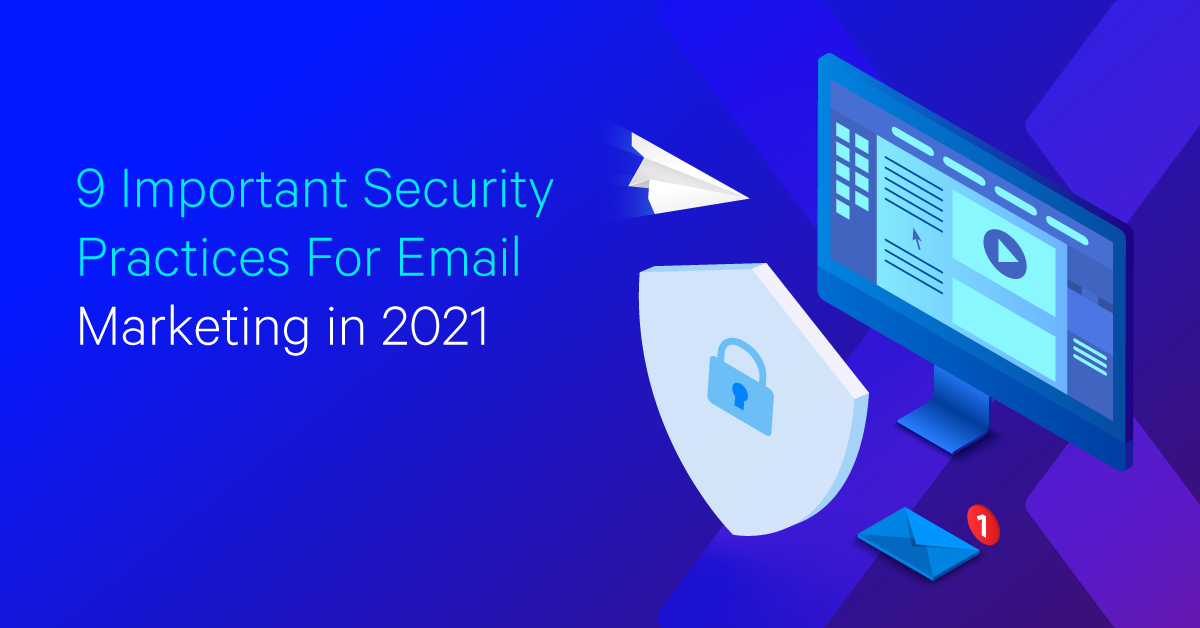9 Important Security Practices For Email Marketing

Hand off the toughest tasks in SEO, PPC, and content without compromising quality
Explore ServicesEmail marketing is still one of the most effective marketing channels in 2022. In fact, due to the Covid-19 crisis, people have become even more eager to stay up to date with the businesses they love. So, email marketing has grown in popularity over the last year, and this is a trend that’s likely to continue well into the future.
The number of email users worldwide has been growing rapidly and is expected to reach 4.48 billion in 2024. This number, along with the growing rate of emails sent and received worldwide every day, is a clear indicator that email marketing is here to stay as an effective marketing tool.
Marketing emails tend to be one of the biggest targets for hackers and cybercriminals because they’re so important for generating revenue for a business. So, security needs to be a top priority.
Simply keeping the password of your email account unique and secure isn’t enough, though. Marketing emails often contain sensitive information about customers and businesses that can attract hackers. This is why we often see marketing campaigns being targeted to steal consumer details or ruin a company’s reputation.
To protect your email account from modern threats, you must also ensure that you:
- Protect the contents of emails during transmission
- Check the content of emails for links to malicious sites and spam
- Authenticate and authorize secure access to accounts
- Check the integrity and functionality of your chosen mail program
Let’s dive deeper into how you can keep your email marketing campaigns safe.
1. Provide Email Content Protection
There are a lot of ways your emails can easily fall under the control of intruders. Therefore, there are several additional layers of protection you’ll need.
One of the most common types is the encryption of content at the transport stage, which ensures the security of messages during transmission over the internet. This method is similar to putting a letter in an envelope — you can see from where to where the notification is going, but its content can be seen only after opening the so-called “envelope”.
Another method of protecting mail is full data encryption. The essence of this method lies in the fact that the message is encrypted by the sender and decrypted by the recipient. While in the process of transmission, it has an encrypted form.
2. Protect Mailboxes From Spam
Quite often, spam and infected messages that contain malicious software are distributed by email. To protect people from unwanted and malicious messages, most mail servers offer a blacklist of known senders of spam and phishing emails.
You can also use email phishing protection software to help protect your organization’s inboxes.
You can protect your email, data, and users with a variety of methods that stop threats like ransomware, spear-phishing, and malware. The SPF record checker tool, DMARC record generator, and DKIM record generator are all tools that have been designed for this. They’ll help to protect you from fake emails through different types of authentication. Here’s what you need to know about them:
- SPF: A Sender Policy Framework helps to protect domains from spoofing and ensures messages are delivered correctly. SPF is an email authentication method that allows domain owners to authorize who sends emails on their behalf.
- DMARC: Domain-Based Authentication, Reporting, and Message Consistency is an email authentication, policy, and reporting protocol.
- DKIM: DomainKeys Identified Mail could also be referred to as email signing. This method allows the sender to take responsibility for the sent email. It is a digital signature that can be verified by receiving servers.
You can also filter messages by attachment type, or only allow messages from trusted sources. To help protect their users’ mail, many organizations scan messages for malware and viruses before they spread across the network.
3. Increase Email Security With Authorization and Authentication
Attackers often use a simple method to spread threats via email — they disguise malicious emails as legitimate ones. You can prevent this by authenticating message content, which means creating a digital verification key that is linked to your domain and controlling which users are allowed to send messages on your organization’s behalf.
Authenticating your messages’ content also means protecting it from being tampered with and ensuring that every email you send will arrive in the exact way it was sent.
Authentication and authorization are both important parts of managing your mail server. You should also quickly delete — or at least change the passwords for — accounts that are no longer in use. This includes the accounts of employees who no longer work for your company.
Multi-factor authentication is one of the most effective forms of protection for email and account access. Personal identification is carried out using a one-time key, which is sent in an SMS message. It’s a good idea to enable this on all of your email accounts to give you and your customers an added layer of protection.
4. Have Protection and Safety Protocols
The Simple Mail Transfer Protocol, or SMTP, does not have built-in security. SMTP is a server that’s essential purpose is to send, receive and/or carry outgoing emails between senders and receivers.
When an email is sent, the SMTP server processes the email, chooses which server to send the message to, and transports the message to said server. The recipient’s email service provider, like Gmail, downloads the email and places it in the inbox. Since SMTP does not have built-in security, email users must use different protocols and protections to keep their messages safe.
These protocols and protections are structures that protect emails from outside interference. In addition to special programs designed to protect data transmitted over open channels, common tools include:
- Mail antiviruses such as VIPRE Antivirus Plus and BullGuard Internet Security — they scan received mail for malware
- Programs, such as Spamfighter and Zerospam, that detect spam and filter unauthorized mailings
- Mail protocols like POP3, SMTP, NNTP, and IMAP. Interception of invalid types of correspondence and their investigation will occur automatically
Antivirus programs are automatically embedded in Microsoft Office Outlook (Microsoft SmartScreen®) and The Bat! modules that filter unwanted traffic and protect mail from spam.
5. Raise Awareness
The worst thing a public-facing corporation can do when it comes to internet security is pretend that hackers and viruses don’t exist. This approach will present your business as either recklessly naive or unconcerned about your customers’ safety. Let your customers know what to look out for when it comes to scams and spread awareness within your emails, blogs, and FAQ sections.
Teach your customers what spam looks like, stressing the value of double-checking a message’s “From” address. Additionally, users should be advised not to click on links or open attachments from unknown sources.
6. Keep Internal Systems Clean
It’s a good idea to go the extra mile to keep your internal systems and servers clean. Many of the largest hacks and cyberattacks originate inside an enterprise, either as a result of a malicious employee or a social engine incident.
IT departments within an organization should maintain careful records on who has access to certain types of data. Make these policies as restrictive as possible, particularly when dealing with sensitive information like email addresses or passwords.
As an email marketer, you have to make sure that there are no loose ends in your systems, and checking them routinely can help you detect any defects before they become problems. It goes without saying that, if you are working within a team, you should always make sure the data available within your corporation is kept safe and confidential.
Start with yourself and spread awareness of the biggest threats and causes of malware that your team should know about. You can also put some preventative processes in place, such as:
- Regularly scanning business emails with adequate software to look out for technical or safety issues
- Consistently cleaning out email lists and filtering out spam and suspicious email addresses
- Keeping business email lists confidential with restricted access
- Setting up internal risk audits to identify your vulnerabilities and assess the risks you face
Most of the risks will come from within your organization. This doesn’t have to be due to premeditated breaches caused by employees — honest mistakes happen. But you can reduce the risk by carrying out regular checks.
7. Filter Your Outbound Emails
Nowadays, most businesses will send large batches of emails to reach potential clients and leads. For example, email marketing is often used to raise awareness of a brand, let customers know about special offers, or even as part of an SEO campaign. It’s worth keeping in mind that you can never be too careful when sending these emails out.
Try incorporating another layer of security before sending out email blasts. One relatively painless approach is to add a firewall to filter outgoing emails.
Hackers have invented intrusions that can intercept outgoing email and infect it with malicious viruses or attachments. Stopping this kind of attack is critical for your company’s credibility as well as the protection of your customers’ data. A good firewall will detect and stop dangerous messages.
8. Invest In Secure Providers
The protection of your outgoing email campaigns must start at the root level. Consider what internet service provider (ISP) you’re using and check what kinds of protections it offers. If your ISP is vulnerable to hacking or other bugs, it puts your business and its financial future at risk.
You should also assess your website hosting provider, and any other companies you trust with your customers’ data. There are plenty of free web hosting options available on the market, such as WordPress, Wix, or Weebly, but they often come with security risks. To make money, some people sell the data on the dark web.
Hosting providers such as Hostgator, Bluehost, and Dreamhost are paid for, but provide robust security for your domain.
In addition, consider implementing a third-party Microsoft 365 backup solution to protect your critical business communications if you are using Microsoft Outlook as your email provider, because it’s native backup capabilities aren’t sufficient for comprehensive data protection
9. Address Remote Working Problems
If your business is multinational or requires workers to operate from various places, it’s important to factor this into your IT protection policies. This is because hackers often congregate and launch attacks on public Wi-Fi networks.
Thankfully, there are ways to shield yourself from this.
A virtual private network will serve as a secure tunnel between a user’s device and your company’s internal resources. It uses an encryption method, which means that, even if intruders intercept traffic, they won’t be able to decipher the data.
With this approach, back-end systems and email tools will be locked and inaccessible to those who aren’t using your VPN. In order to ensure extra security, you could consider investing in email marketing software or a customer relationship management tool like Zoho, Hubspot, or Salesforce, as they offer additional security features.
Conclusion
A lot of businesses make the mistake of neglecting important security practices when it comes to their email marketing, but this can put both your customers’ and companies’ inboxes at risk.
By taking these tips on board, you can prevent security breaches, protect your customers’ data, and prevent your business’s reputation from being tarnished by a hacking or phishing scam.
Hand off the toughest tasks in SEO, PPC, and content without compromising quality
Explore ServicesWritten by Araz Guidanian on April 1, 2021
Araz Guidanian is part of the marketing team at easydmarc.com. She writes content about email protection and the future of cybersecurity.





